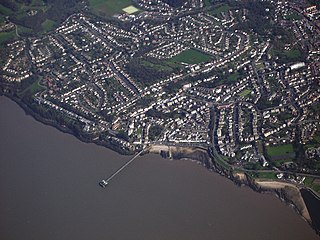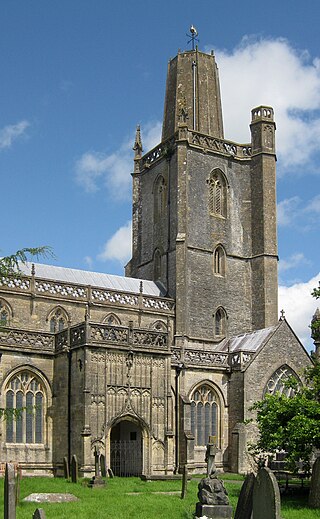Related Research Articles

North Somerset is a unitary authority in the ceremonial county of Somerset, England. The council is based in Weston-super-Mare, the area's largest town. The district also contains the towns of Clevedon, Nailsea and Portishead, along with a number of villages and surrounding rural areas. Some southern parts of the district fall within the Mendip Hills, a designated Area of Outstanding Natural Beauty.

Clevedon is a seaside town and civil parish in the unitary authority of North Somerset, England. It recorded a parish population of 21,281 in the United Kingdom Census 2011, estimated at 21,442 in 2019. It lies along the Severn Estuary, among small hills that include Church Hill, Wain's Hill, Dial Hill, Strawberry Hill, Castle Hill, Hangstone Hill and Court Hill, a Site of Special Scientific Interest with overlaid Pleistocene deposits. It features in the Domesday Book of 1086. Clevedon grew in the Victorian period as a seaside resort.

Nailsea is a town in North Somerset, England, 8 miles (13 km) southwest of Bristol, and 11 miles (18 km) northeast of Weston-super-Mare. The nearest village is Backwell, which lies south of Nailsea on the opposite side of the Bristol to Exeter railway line. Nailsea had a population of 15,630 in the 2011 Census.

Burnham-on-Sea is a seaside town in Somerset, England, at the mouth of the River Parrett, upon Bridgwater Bay. Burnham was a small fishing village until the late 18th century when it began to grow because of its popularity as a seaside resort.

Portishead is a town and civil parish in the North Somerset unitary authority area, in the county of Somerset, England. With a population of 26,366 at the 2021 Census, the town is located on the Severn Estuary opposite Cardiff and Newport in Wales. The town is 8 miles (13 km) to the west of Bristol and 18 miles northeast of Weston-super-Mare.

Yatton is a village and civil parish within the unitary authority of North Somerset, which falls within the ceremonial county of Somerset, England. It is located 11 miles (18 km) south-west of Bristol. Its population in 2011 was 7,552. The parish includes Claverham, a small village which was originally a farming hamlet.

Backwell is a village and civil parish in the unitary authority of North Somerset and in 2011 had a population of 4,589. The village lies about 7 miles (11 km) southwest of Bristol, south of the A370 to Weston-super-Mare. The parish includes the hamlets of Backwell Common, Backwell Green, and Backwell Farleigh, and the districts of Backwell West Town and Downside.
Clevedon School, formerly known as Clevedon Community School, is a coeducational secondary school located in Clevedon, North Somerset, England. It has over 1350 pupils, in years 7 to 11 in the Lower School and 12 to 13 in the Upper School or sixth form. The school recently regained its Language College status. As of 2023, the headteacher is Jim Smith. The school was part of the Clevedon Learning Trust, a Multi-Academy Trust formed on 1 January 2015 by CEO John Wells. As of 1st March 2023, Clevedon Learning Trust merged with Futura Learning Partnership, with schools in Bristol, North Somerset and Somerset.

Clevedon Town Football Club is a semi-professional football club representing Clevedon, Somerset, England. Affiliated to the Somerset County FA, they are currently members of the Western League Premier Division and play at the Hand Stadium in Kenn.

Weston-super-Mare Association Football Club is a semi-professional football club based in Weston-super-Mare, Somerset, England. Nicknamed "The Seagulls", the club is affiliated to the Somerset County Football Association and are competing in the National League South, the sixth tier of English football.

Worle is a village in the civil parish of Weston-Super-Mare, in the North Somerset district, in the ceremonial county of Somerset, England. It is joined to the seaside town of Weston-super-Mare on its western edge. It, however, maintains a very separate identity, and may now be bigger than its more famous neighbour. Worle pre-dates Weston and was mentioned in the Domesday Book of 1086. In the book, it is said that Worle was owned by Walter of Douai, and consisted of 750 acres (3.0 km2) and valued at 6.5 hides. "Walter of Douai holds of the King, Worle. Edgar held it in the time of King Edward, and gelded for six hides and a half." The parish church of St Martin's sits on the side of Worlebury Hill and overlooks the village.

Brandon Hill, also known as St Brandon's Hill, is a hill close to Bristol city centre, between the districts of Clifton and Hotwells, in south west England.

Hans Price (1835–1912) was the architect responsible for much of the development of Weston-super-Mare, in North Somerset, England, during the Victorian era.
Somerset Premier is an English rugby union league which sits at the eighth level of league rugby union in England involving teams based in the county of Somerset as well as some teams based in Bristol. Originally a single division called Gloucestershire/Somerset, in 2000 the division split into two county leagues called Gloucester Premier and Somerset Premier.
Counties 1 Western North is an English rugby union league. Originally a single division called Western Counties, in 1996 the division split into two regional leagues called Western Counties North and Western Counties West. Western Counties North was renamed Counties 1 Western North prior to the 2022–23 season and is currently a seventh tier league for clubs based in the south-west of England; mainly Bristol, Gloucestershire and Somerset. The champions are promoted to South West 1 West and the runner-up plays the second team in Western Counties West, with the winning team gaining promotion. The number of teams relegated depends on feedback following promotion and relegation in the leagues above, but is usually two or three to Gloucester Premier and Somerset Premier. Although 2nd XV rugby is part of the Somerset regional league system, only 1st XV teams are allowed in Tribute Western Counties North.
The City of Bath Technical School in Bath, Somerset, England had various roles from the late 19th century until 1970. It obtained its official name when technical schools were formally introduced in Bath between the years 1892 and 1896, and at first was housed in a new extension of the Guildhall. The school was transformed in the early 20th century, when it was combined with several other institutions, and then evolved through various sites and roles until its closure at Brougham Hayes, Lower Oldfield Park in 1973 after being renamed in 1971 as Culverhay School.

Clevedon Hall is a mansion with 17 acres (6.9 ha) of land in Clevedon, North Somerset, England. It is a Grade II* listed building. It is not to be confused with Cliveden on the Thames near Taplow, nor other houses with similar names.
John Foster, was an English architect and partner in the architectural practice of Foster & Wood of Park Street, Bristol who designed a number of well known buildings erected in Bristol in the 19th century. "It must sometimes seem that the whole of 19th-century Bristol, or at least all of its significant buildings, owed their design to the firm of Foster and Wood".
Somerset 1 is an English rugby union league which sits at the ninth level of league rugby union in England involving teams based in the county of Somerset as well as some teams based in Bristol. 1st, 2nd and even 3rd XV sides can participate in the division as long as they are not from the same club.
References
- 1 2 3 4 5 "Clevedon Hall – a glimpse into its past". Clevedon Hall Estate. 2010. Archived from the original on 1 September 2010. Retrieved 14 April 2010.
- 1 2 3 4 5 6 7 8 "Records of St Brandon's School". Archives. Bristol City. Retrieved 1 September 2013.
- ↑ "Clergy Daughters' School, Great George Street, Brandon Hill". Bristol Information – List All Schools. Bristol Web. Retrieved 9 May 2018.
- ↑ "St Brandon's Clergy Daughters' School". Bristol Records Office 1930s–1942. The National Archives. Retrieved 14 April 2010.
- 1 2 3 "Clevedon Hall, (also known as St. Brandon's School), Bristol, England". History. Parks & Gardens Data Services. 27 July 2007. Retrieved 14 April 2010.
- ↑ "Arson at old St Brandons school, Clevedon". Clevedon people. Archived from the original on 12 January 2014. Retrieved 12 January 2014.
- ↑ "Clevedon Hall Development Brief – Consultation draft". North Somerset Area. 13 April 2006. Retrieved 14 April 2010.
- ↑ "St Brandon's School, Clevedon, Somerset, UK". Urban-Explorers forum. StumbleUpon. 31 October 2006. Retrieved 14 April 2010.
- ↑ "UK storm payout 'may hit £350m'". news.bbc.co.uk. BBC. 20 February 2007. Retrieved 20 February 2007.
A block of stone fell onto a dinner hall at a school in Bristol killing one girl and injuring five others.
- ↑ Johnson, Angella; Brown, Paul; Buckingham, Lisa (26 January 1990). "Storm wreaks deadly havoc". The Guardian. Guardian News and Media. Retrieved 14 April 2010.